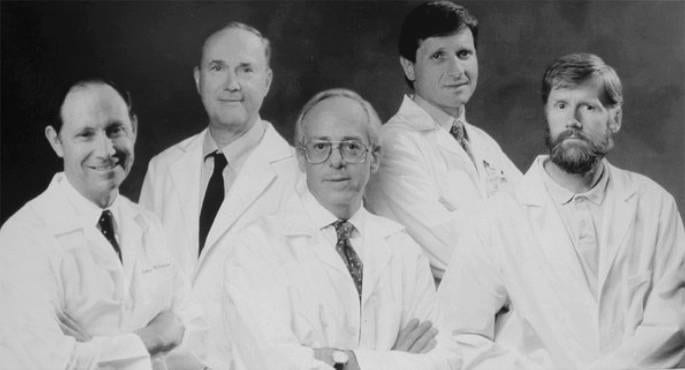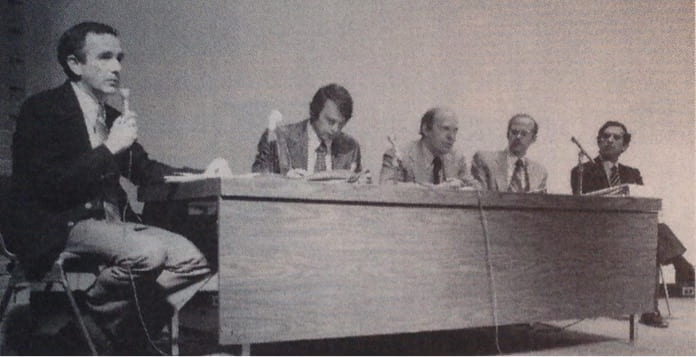The University of Chicago has a long tradition of being at the forefront of endocrinology and endocrine surgery research. Here is a brief summary of some of the most important discoveries made by physicians and scientists from the University of Chicago:
- Charles B. Huggins, MD, a Canadian-American surgeon and cancer researcher at the University of Chicago was awarded the Nobel Price for Physiology and Medicine in 1966 for discovering that hormones could be used to control the spread of some cancers, including prostate cancer.
- Donald Steiner, MD showed in 1967 that insulin, thought to be made from two separate protein chains, began instead as a longer single chain, which he named proinsulin. This fundamental discovery paved the way to understanding how other hormones are made and processed. It established the field of protein-precursor processing and enabled the pharmaceutical industry to improve the purity of insulin preparations.
- Arthur H. Rubenstein, MD, an endocrinologist working with Dr. Steiner documented the importance of proinsulin as a marker of the pre-diabetic state and in the diagnosis of insulinoma and then identified and characterized patients with mutations in both insulin and proinsulin.
- Kenneth Polonsky, MD, the current dean of the Division of Biological Sciences and the Pritzker School of Medicine studied factors that influence the health and function of pancreatic beta cells. Dr. Polonsky was part of a team at the University of Chicago in the 1980s that developed and tested ways to measure insulin-secretion rates via direct intra-arterial calcium stimulation.
 Left to right: Arthur Rubenstein, Donald Steiner, Howard Tager, Kenneth Polonsky, and Graeme Bell.
Left to right: Arthur Rubenstein, Donald Steiner, Howard Tager, Kenneth Polonsky, and Graeme Bell.
- Samuel Refetoff, MD, is considered the father of translational thyroidology. His work focuses on identifying genetic errors that cause defects in thyroid hormone regulation, synthesis, transport and action. Amongst many discoveries he was the first to identify a mutation in the thyroid hormone receptor β gene in 1989, and demonstrate that the recessively inherited form of Refetoff Syndrome resistance to thyroid hormone (RTH) is caused by complete deletion of the TRβ gene.
- Leslie DeGroot, MD, a renowned endocrinologist was known for improving the understanding of thyroid hormone synthesis and its mechanism of action. Together with Samuel Refetoff he discovered that 40 per cent of adults operated upon for thyroid carcinoma had a prior history of neck irradiation at other institutions. In 1975, they published a landmark study in the New England Journal of Medicine documenting the link between papillary thyroid carcinoma and radiation exposure.
- Paul Harper, MD, a professor of surgery and radiology introduced technetium-99m into clinical practice in the early 1960s as a radiotracer agent. He also developed the commercial method for producing iodine-125. Both radiotracers are still frequently used for thyroid diagnostics to this date.
- Edwin Kaplan, MD, an illustrious academic surgeon and researcher has been part of the department of surgery for 53 years. His contributions to the field of endocrine surgery have been innumerable. He was part of the team that described the link between thyroid cancer and radiation exposure. He wrote the chapter on thyroid and parathyroid surgery in every edition of Schwartz’s Textbook of Surgery from 1970 to 1994. Dr. Kaplan has operated on over 12,000 patients, helped train nearly 5,000 students and 1,000 residents, written more than 200 scientific papers, edited two books and authored one. He was also one of the founding members and second President of the American Association of Endocrine Surgeons (AAES).
 First annual Meeting of the AAES in Ann Arbor, Michigan, 1980 (Ed Kaplan sitting far right)
First annual Meeting of the AAES in Ann Arbor, Michigan, 1980 (Ed Kaplan sitting far right)

